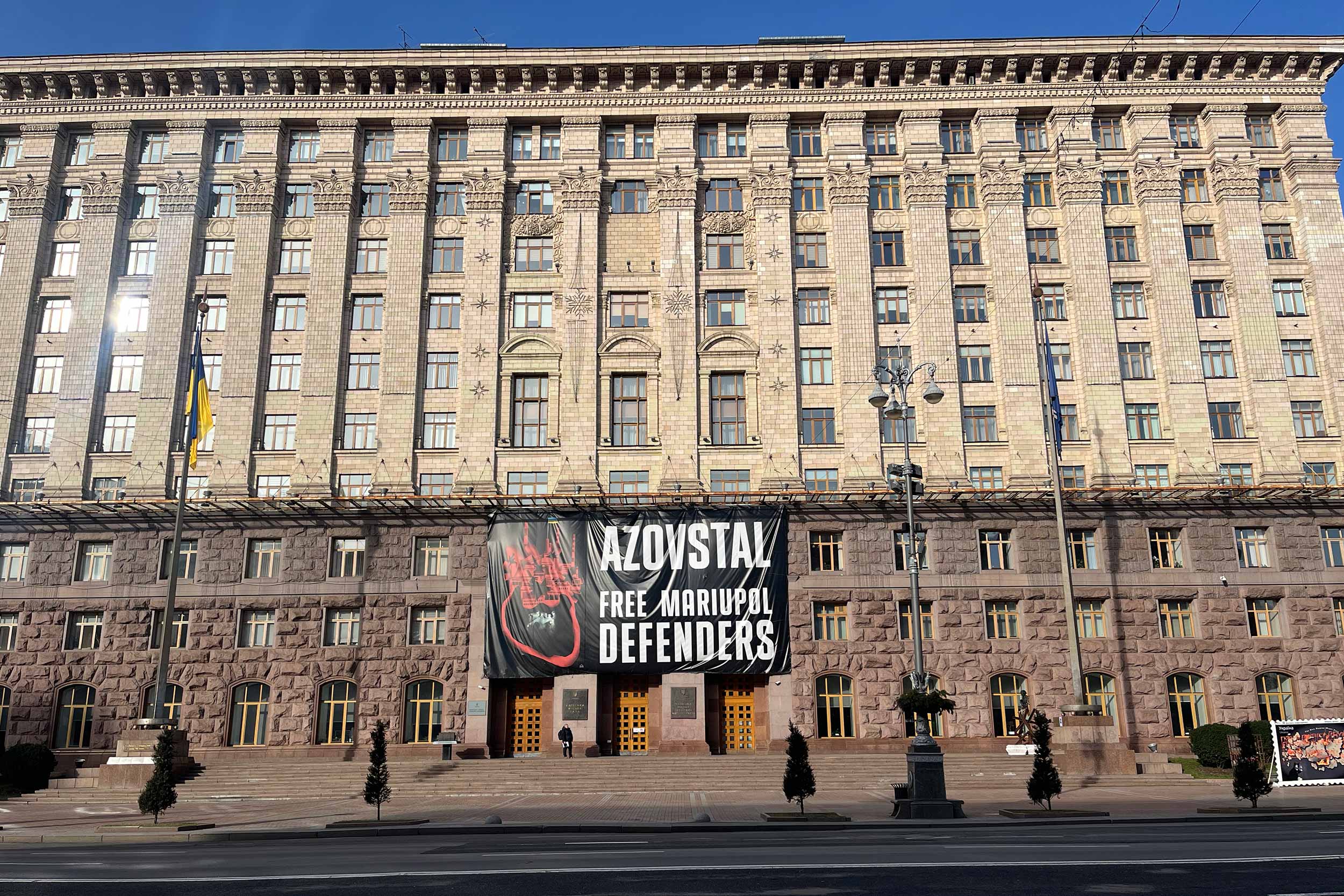Ukraine’s Uncertain Prospects
Two years into the full-scale war, a nation grapples with questions over international support, military capacity and its own unity.
Life in the trenches is cold, and Volodymyr Omelyan – a former infrastructure minister who joined the army at the outbreak of the full-scale invasion – still feels the chill from his many months on the southern front. Yet the greater challenge, he says, is the uncertainty.
“I felt like I was in a casino, and I didn’t like it,” he continued. “You can calculate the risk, but then it’s only good luck or bad. You hit a target or the target hits you. You fire and then you become the target yourself. The very fact of firing is a risk, incoming and outgoing. So it’s fire and move, fire and move.”
Ukraine continues to fight bravely. But two years on, it is grappling with uncertainty – over international support, military capacity and its own unity in keeping up the fight. Is it moving fast enough?
Weapons supply remains the critical challenge. With the MAGA rump in Congress withholding support, all eyes are on Washington, and on the presidential election ahead.
Avdiivka, the Donetsk industrial town defended for a decade, was lost primarily because of the arms shortage. Defenders talk of harsh aerial bombardment and huge numbers attacking in waves.
As Ukraine sought to set a new defensive line, Russia seized three westward villages. It is now probing for weaknesses across the entire front, with commanders registering an immediate increase in artillery attacks in other areas as soon as Avdiivka fell.
Modest earlier Ukrainian gains south in Zaporizhzhia are at risk, and Kupiansk outside of Kharkiv in the north is under severe pressure.

“I don’t know why everyone talks about stalemate,” said a Ukrainian security analyst in Kyiv. “We are losing ground.”
“War is a poison for any society”
The problem is not only arms, but personnel. Here the supply challenge is Ukraine’s alone, and also difficult to resolve.
With the surge of volunteer sign-ups long tapered off, last autumn then-Commander-in-Chief Valerii Zaluzhnyi called for up to 500,000 new soldiers.
If large conscription and a lowered age of service were inevitable, the president and the top general wrangled over who should take responsibility for such a decision. Now it has been shunted to parliament, where it is stalled by a mountain of potential amendments – more questions than answers about the country’s most painful choice.
Soldiers remain stoical. Sergii, a commander with the National Guard 13th Khartiya Brigade near Yampil, said that troops at the front will stay until victory, with no rush to rotate out however tired they may be. But he acknowledges that the shortage of soldiers means smaller, more vulnerable units, while the lack of weapons increases risk as they ration usage. This means that they can only fire on enemy units which are actively attacking.
“Russians have enough ammunition, so they are hitting our logistics, they are hitting vehicles moving people into position, they are hitting groups of people rotating at positions,” he said. “We cannot allow ourselves to do that.”
The military presence which is so total far out in the east gives way to a contradictory vibe in the capital.
In Kyiv, hip coffee joints proliferate, and best restaurants may need a reservation, even in midweek. Thanks to the robust missile defence, few seem to take notice of occasional air raid sirens.
Yet the questions of arms and soldiers hovers over every conversation. The eyes of a Ukrainian professional woman redden as she talks of her brother at the front, under pressure and short of munitions.
Two men in the technology sector underline their willingness to serve if called, and one routinely checks the readiness of his gear. But neither are in a rush to sign up.
At the same time, many of their friends are lying low, staying off the roads and streets, keen to avoid being questioned at a checkpoint or by roving recruiters. A prominent journalist, meantime, scrolls through communications positions on a military jobs website, wondering when to send in his CV.
Everyone knows more troops are needed. But no one has a good answer for who should go, and why some are called and not others. A division is emerging between those in and out of uniform, those in the cities and those in the trenches.
This points to the third huge challenge: social cohesion.
In the first two years, unity was palpable. Mass displacement caused a great mixing of the population, and everyone volunteered for something.
Time has re-emphasised geographic, professional, social distinctions. Society is not divided, but nor is it as tightly unified as it was. Issues of fairness and of transparency emerge, and politics returns.
“If you talk too much and do nothing, somebody dies."
As the wartime head of state, Volodymyr Zelensky is fully supported. He is recognised for his inspiring addresses to soldiers and citizens, and his role building international support.
But this does not extend to his success in driving reform and clearing out corruption, and not for transparency especially among what is seen as a close clique of powerful advisors. The shine has dimmed.
Was the dismissal in early February of the highly popular Zaluzhnyi because of underperformance in the summer offensive, undisciplined public statements over strategy or political rivalry? The questions linger.

In a country proud of its civic demonstrations, no one is considering taking to the streets. There is consensus that with elections impossible under wartime and martial law, the president’s mandate be extended past what would be the normal term end this May. But none of this is optimal.
“War is a poison for any society,” human rights activist and Nobel peace laureate Oleksandra Matviichuk told me.
The centralising requirements of war, she noted, were opposite to the decentralising requirements of democratisation. So, Ukraine must do both – must succeed at both – at the same time. With no idea when the war might end, it will have to continue to grapple with that balance.
And nothing stands still. Kyiv expects Russian propaganda offensives to try to exploit societal divisions within Ukraine and press the case of Russian military inexorability. By early summer, still in the glow of Putin’s electoral re-anointment, Moscow will surely seek to question Zelensky’s legitimacy.
Yet while Kyiv hopes for a breakthrough on Capitol Hill, Zelensky predicts a major new Russian attack by early summer. He recently announced that a total of 31,000 Ukrainian soldiers had been killed over the past two years – a figure his public widely consider to be an underestimate.
In the east, Pokrovsk, Kramatorsk and the country’s second city of Kharkiv are all at risk. It is not uncommon to hear speculation in the capital that Kyiv itself could come under a fresh major assault. The US military aid bill must pass.
Against such gloom, Ukraine remains resilient. A reconstruction conference is planned, military reform discussion continues, as does lobbying for an aggression tribunal to try Putin.
A 50 billion euro economic package from Brussels has been secured, as well as bilateral agreements with several European countries, and Euro-integration progresses.
The White House just announced a surprise top-up of 300 million US dollars in arms, and six more vital F-16s have been pledged by the Netherlands. Meantime, domestic arms production is increasing. The emerging Ukrainian drone sector wants not only to defeat Russia but also to establish itself as a future global player.
These are positive indications of support. But no one feels it is enough to confront a larger foe whose original war aims remain in place.
“If you talk too much every day and do nothing, somebody dies. And it's not just one unlucky guy. It’s hundreds of us, thousands of us sometimes,” said Omelyan, the former minister, who has recently been transferred from frontline duties.
“As of today, we have more than 450,000 Russian troops standing by our borders, ready to attack – to attack from the South, from the East, from Kharkiv simultaneously. Do we have enough resources to reply?”
